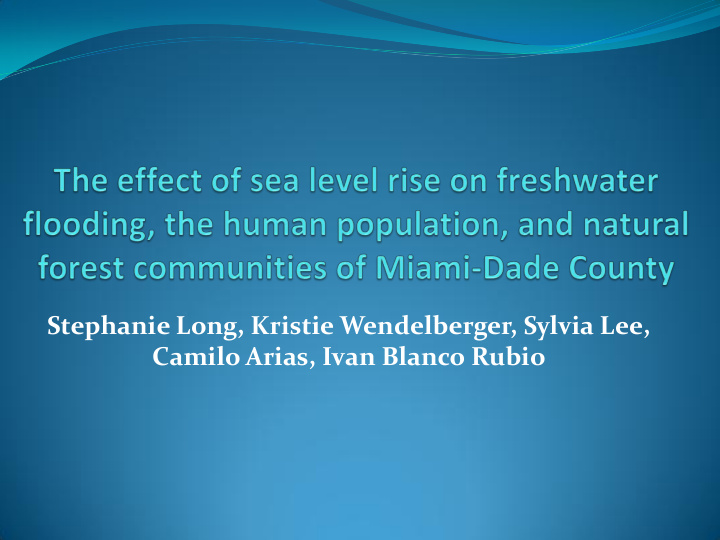



Stephanie Long, Kristie Wendelberger, Sylvia Lee, Camilo Arias, Ivan Blanco Rubio
Background Reasons for SLR: Thermal expansion due to global climate change. Possible acceleration due to glacial melting.
Background (cont.) Local SLR: SLR has regional variation. Florida SLR trends match global projections. Impacts on Miami-Dade Lowest continental aquifer in the US. Some inland elevations at or below sea level. Freshwater flooding, a result of the shallow water table.
Sustainability Concepts for Miami-Dade Potential for resilience? Project evaluates SLR impacts on a CHES, providing background for future sustainability initiatives. Displacement Flooding displaces human population groups and natural forest communities. Inclusive Wealth Project can be used as a parameter for an inclusive wealth model of Miami-Dade.
Project Question and Hypothesis How will projected sea level rise scenarios affect the interactions between sea water and freshwater flooding, natural forest communities, and the human population of Miami-Dade County? Based on SLR scenarios of 0.5 m, 1 m and 2 m, we predict: Saltwater intrusion will threaten freshwater supply. Flooding may impact population groups based on socioeconomic status and location of residence. Flooding will impact the number and percent of remaining NFCs.
Link 1: SLR to Water Flooding Flooding mostly in the wetlands. The coastal ridge remains mostly unaffected until the 2.0 m SLR scenario.
Link 1 (cont.) Saltwater vs Freshwater flooding Inland flooding is freshwater. Saltwater flooding along the coast and in the wetlands. Some areas of SW flooding in the “Finger Glades”.
Intrusion (feet) SLR Max Min Average St. Dev. Link 1 (cont.) 0.5 m 785.98 10.67 117.33 138.47 1.0 m 1567.18 21.33 233.11 273.13 2.0 m 3134.36 42.66 466.23 546.27 Saltwater Intrusion Data suggests a Distance to the shoreline maximum intrusion of Aquifer Depth only 3,000 ft
- Partial and completely inundated polygons - Census blocks (30809) - Census block groups (1223)
Link 2: Census blocks, race Population distribution by census 2000 and affected by different SLR scenarios. Census 2000 0.5m 1m 2m Population 2,253,362 651,872 866,635 1,805,180 White 1,570,558 (12.4) 503,941 (19.4) 660,297 (16.9) 1,332,769 (12.5) Hispanic 1,291,737 (57.3) 377,394 (57.9) 514,083 (59.3) 1,106,788 (61.3) Black 457,214 (20.3) 79,441 (12.2) 114,217 (13.2) 287,196 (15.9) Other 225,590 (10.0) 68,490 (10.5) 92,121 (10.6) 185,215 (10.3)
Link 2: Census blocks, race Evolution of affected population by race 100 90 80 70 Percentage 60 0.5m 50 1m 40 2m 30 20 10 0 Population White Black Other Hispanic
Link 2: Block Census Group, income White Hispanic Ratio of income to poverty level 8% 4% Under .50 50 to .74 6% 75 to .99 6% 1.00 to 1.24 Black 1.25 to 1.49 6% 60% 1.50 to 1.74 1.75 to 1.84 5% 1.85 to 1.99 3% 2.00 and over 2%
NFCs to Water
Link 3: NFCs to Water 698 NFCs in MDC. 120 effected at 2m. 741 County and Municipal Parks in MDC. 27 with NFCs. 20% affected by 0.5m SLR. 30% affected by 1.0m SLR. 74% affected by 2.0m SLR. 172 rare species in MDC.
Link 3 (cont.) Acres of NFCs effected by SLR 700 600 500 NFC Acreage 400 300 200 100 0 0.5 m 1 m 2 m
Link 3 (cont.) Acreage of Parks w/NFCs effected by SLR 4500 4000 3500 Park Acreage 3000 2500 2000 1500 1000 500 0 0.5 m 1 m 2 m
Link 4: Humans to NFCs Good news: 74% of parks with NFCs acquired or managed by EEL program. 23,000+ acres as of Sept. 2010. 714 other parks.
Link 4: Humans to NFCs (cont.) Environmentally Endangered Lands (EEL) - 1990 Run by Board of County Commissioners. Vulnerable, low-lying lands with special natural features. Tax breaks for owners (based on acreage). Must follow 10 year management plan, updated at least every 5 years, inspection every year. Development highly unlikely. Climate Change Advisory Task Force – 2006 Advises Mayor and Board of County Commissioners. GreenPrint – MDC chosen as pilot community in 2009 Assessment and Goals made as Milestones 1 and 2. Currently on Milestone 3: Planning. Milestone 4: Implement. Milestone 5: Monitor/Evaluate.
Link 4: Humans to NFCs (cont.) Value of recreational parks and green space in urban areas. 16% affected by 0.5m SLR. 25% affected by 1.0m SLR. 40% affected by 2.0m SLR. Types of management City, County. 15% undeveloped. Potential for development?
Conclusions 1) Extensive flooding in low-lying wetlands and coastal areas. 2) Influence of SLR scenarios on socio-economic groups. 3) SLR will impact NFCs and, in turn, rare plant populations. 4) MDC has positive initiatives for protecting NFCs.
Recommend
More recommend